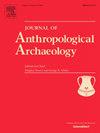Mold-making technology at architectural compound 60 (CA-60): A newly discovered ceramic workshop at Huacas de Moche, Peru
IF 2.2
1区 社会学
Q1 ANTHROPOLOGY
引用次数: 0
Abstract
Ceramic molding is often addressed as a simple, repetitive, and standardized technique. Similarly, mold-making, though much less studied than molding itself, is frequently viewed as equally straightforward. Yet what specific gestures, techniques, and tools are involved in mold-making? Does internal technical variability exist behind apparent external standardization? What insights into ancient craft production can mold-making evidence provide? This paper addresses these questions through a technological study of molds from a recently discovered ceramic workshop at Huacas de Moche (Trujillo, Peru). Our study reveals that mold-making comprises multiple complex sequential steps with significant technological variation. We suggest that local Moche artisans maintained autonomy in their mold production methods, employing diverse technological approaches while sharing a common artistic repertoire, meanwhile elite oversight ensured quality standards in final products.
建筑大院60 (CA-60)的模具制造技术:秘鲁Huacas de Moche新发现的陶瓷车间
陶瓷成型通常被认为是一种简单、重复和标准化的技术。同样地,模具制造虽然比成型本身研究得少得多,但通常被视为同样简单。然而,模具制作中涉及到哪些具体的手势、技术和工具呢?在明显的外部标准化背后是否存在内部技术可变性?模具制造的证据能提供什么关于古代工艺生产的见解?本文通过对最近在Huacas de Moche (Trujillo,秘鲁)发现的陶瓷车间的模具进行技术研究,解决了这些问题。我们的研究表明,模具制造包括多个复杂的连续步骤,具有显著的技术变化。我们建议当地的莫切工匠在模具生产方法上保持自主权,采用不同的技术方法,同时分享共同的艺术曲目,同时精英监督确保最终产品的质量标准。
本文章由计算机程序翻译,如有差异,请以英文原文为准。
求助全文
约1分钟内获得全文
求助全文
来源期刊

Journal of Anthropological Archaeology
Multiple-
CiteScore
4.00
自引率
11.10%
发文量
64
期刊介绍:
An innovative, international publication, the Journal of Anthropological Archaeology is devoted to the development of theory and, in a broad sense, methodology for the systematic and rigorous understanding of the organization, operation, and evolution of human societies. The discipline served by the journal is characterized by its goals and approach, not by geographical or temporal bounds. The data utilized or treated range from the earliest archaeological evidence for the emergence of human culture to historically documented societies and the contemporary observations of the ethnographer, ethnoarchaeologist, sociologist, or geographer. These subjects appear in the journal as examples of cultural organization, operation, and evolution, not as specific historical phenomena.
 求助内容:
求助内容: 应助结果提醒方式:
应助结果提醒方式:


